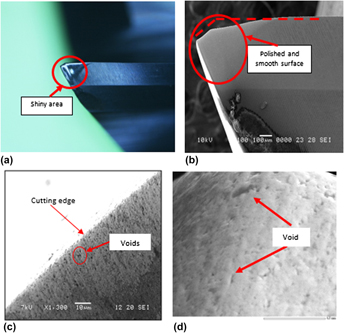Crossref Citations
This article has been cited by the following publications. This list is generated based on data provided by
Crossref.
Xiang, Daohui
Feng, Haoren
Guo, Zhenhai
Zhang, Lei
and
Wu, Bangfu
2018.
Preparation technology and properties of microtexture diamond-coated tools.
International Journal of Refractory Metals and Hard Materials,
Vol. 76,
Issue. ,
p.
16.
Xu, Jinyang
Ji, Min
and
Chen, Ming
2020.
On the quantitative analysis of drill edge wear when machining CFRP/Ti6Al4V stacks.
The International Journal of Advanced Manufacturing Technology,
Vol. 108,
Issue. 5-6,
p.
1463.
Nguyen, Dinh
Bin Abdullah, Mohammad Sayem
Khawarizmi, Ryan
Kim, Dave
and
Kwon, Patrick
2020.
The effect of fiber orientation on tool wear in edge-trimming of carbon fiber reinforced plastics (CFRP) laminates.
Wear,
Vol. 450-451,
Issue. ,
p.
203213.
Elgnemi, Tarek-Shaban-Mohamed
Jun, Martin Byung-Guk
Songmene, Victor
and
Samuel, Agnes Marie
2021.
Milling Performance of CFRP Composite and Atomised Vegetable Oil as a Function of Fiber Orientation.
Materials,
Vol. 14,
Issue. 8,
p.
2062.
Hu, Long
Cai, Yan
Yang, Wenfeng
Xue, Wei
Zhu, Dehua
and
Cao, Yu
2021.
Laser selective ablated multistep interfacing for enhanced adhesive bonding joints of carbon fiber reinforced polymer materials.
Journal of Laser Applications,
Vol. 33,
Issue. 4,
Khawarizmi, Ryan
Bin Abdullah, Mohammad Sayem
Han, Yinyin
Kim, Dave
and
Kwon, Patrick
2022.
The Effect of Carbon Fiber Types on Tool Wear During Edge Trimming of 0 deg, 45 deg, 90 deg, and 135 deg Carbon Fiber-Reinforced Plastic Laminates.
Journal of Manufacturing Science and Engineering,
Vol. 144,
Issue. 6,
Kesmanee, Kamonlak
Chanpariyavatevong, Amarin
and
Boongsood, Wanwanut
2022.
Effect of Air Cooling on Tool Wear in Drilling CFRP.
Materials Science Forum,
Vol. 1073,
Issue. ,
p.
103.
Jin, Fan
Bao, Yan
Li, Bohao
and
Jin, Xiaoliang
2022.
Tool wear prediction in edge trimming of carbon fiber reinforced polymer using machine learning with instantaneous parameters.
Journal of Manufacturing Processes,
Vol. 82,
Issue. ,
p.
277.
Xu, Ziyang
and
Wang, Yongguo
2022.
Study on cutting force and surface quality during slot milling of CFRP based on equivalent milling area.
The International Journal of Advanced Manufacturing Technology,
Vol. 123,
Issue. 9-10,
p.
3377.
Fatirah, R. Siti
Norkhairusshima, M. K.
Suhaily, M.
Najiah, D. Aishah
and
Natasha, A. R.
2022.
Proceedings of the 3rd Malaysian International Tribology Conference.
p.
154.
Devan, Deviprakash Jyothi
Almaskari, Fahad
Sheikh-Ahmad, Jamal
and
Hafeez, Farrukh
2022.
A study on tool wear of tungsten carbide cutters in edge trimming of CFRP.
Journal of Mechanical Science and Technology,
Vol. 36,
Issue. 5,
p.
2499.
Gao, Teng
Zhang, Yanbin
Li, Changhe
Wang, Yiqi
Chen, Yun
An, Qinglong
Zhang, Song
Li, Hao Nan
Cao, Huajun
Ali, Hafiz Muhammad
Zhou, Zongming
and
Sharma, Shubham
2022.
Fiber-reinforced composites in milling and grinding: machining bottlenecks and advanced strategies.
Frontiers of Mechanical Engineering,
Vol. 17,
Issue. 2,
Irfan, K. Muhammad
Khairusshima, M. K. Nor
Natasha, A. R.
Najiah, D. Aishah
and
Suhaily, M.
2023.
Proceeding of 5th International Conference on Advances in Manufacturing and Materials Engineering.
p.
599.
Mu, Han
Zhang, Boyu
Wei, Gang
Hu, Xiaohang
and
Wang, Fuji
2023.
Experimental study on wear laws and mechanisms of end cutting edge in end-milling of carbon fiber reinforced polymer.
The International Journal of Advanced Manufacturing Technology,
Vol. 125,
Issue. 11-12,
p.
5397.
WU, Weizhou
LI, Shipeng
QIN, Xuda
LIU, Wentao
CUI, Xin
LI, Hao
SHI, Mengrui
and
LIU, Haibao
2023.
Effects of fiber orientation on tool wear evolution and wear mechanism when cutting carbon fiber reinforced plastics.
Chinese Journal of Aeronautics,
Vol. 36,
Issue. 5,
p.
549.
Geier, Norbert
Xu, Jinyang
Poór, Dániel István
Dege, Jan Hendrik
and
Davim, J Paulo
2023.
A review on advanced cutting tools and technologies for edge trimming of carbon fibre reinforced polymer (CFRP) composites.
Composites Part B: Engineering,
Vol. 266,
Issue. ,
p.
111037.
Kong, Xianjun
Wang, Yaodi
Liu, Xiaole
Dang, Zhanpeng
and
Wang, Minghai
2024.
Research on the removal mechanism and surface damage of laser assisted cutting of CFRP materials.
Journal of Manufacturing Processes,
Vol. 124,
Issue. ,
p.
196.
Li, Shipeng
Huang, Siming
Li, Hao
Liu, Wentao
Wu, Weizhou
and
Liu, Jian
2024.
Multi-condition tool wear prediction for milling CFRP base on a novel hybrid monitoring method.
Measurement Science and Technology,
Vol. 35,
Issue. 3,
p.
035017.
Di Bella, Guido
El Bahaoui, Jalal
and
Chairi, Mohamed
2024.
Machining Polymer Matrix Composites.
p.
65.
Riaz, Ali
Yuan, Zewei
and
Chohan, Bilal shabbir
2024.
Investigation of the micro-cutting mechanism of T700 CFRP composites using ultra-thin dicing blade.
The International Journal of Advanced Manufacturing Technology,
Vol. 135,
Issue. 7-8,
p.
3159.




